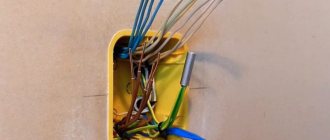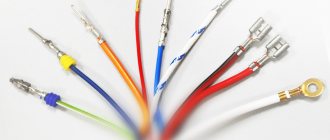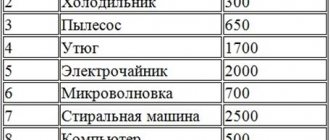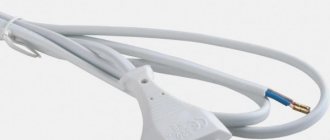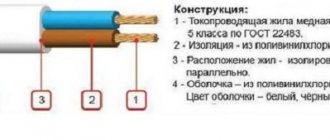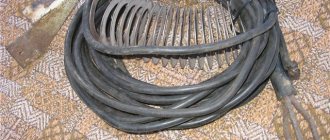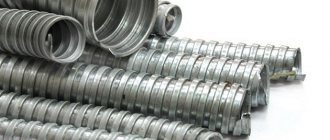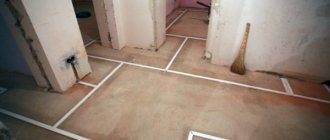Electrical wiring is a necessity, without which there will be no light and not a single electrical appliance will work. During installation or repair work, craftsmen use crimping for electrical cable lugs, which ensures a high level of safety and reliability of the wire connections. Read and understand what it is and why it is needed. We will tell you about lugs for electrical wires, types of crimping and the nuances of connecting cables with a special tool.
Ferrules and special tools for crimping electrical wires Source asset.conrad.com
General information about using tips and sleeves
If the connection of the electrical wires is not tight, then the contact point will heat up. The result could be a fire. In addition, a loose connection will not provide the required throughput. This will lead to unstable operation of the power grid and, possibly, failure of electrical equipment.
When crimping wires is performed, the listed troubles can be avoided. The process itself involves crimping electrical cables using special lugs.
Usually craftsmen do the work with crimpers. They provide high-quality connections with the required density. A special tool for electrical wires is also called crimpers. With their help, the connection is crimped using mechanical action, which allows:
- carry out installation and repair work as quickly as possible;
- create, in most cases, a permanent connection that can withstand significant breaking loads;
- ensure a continuous flow of electrical current in a particular circuit even under difficult operating conditions.
The crimper speeds up installation and creates a reliable permanent connection Source kabeltut.ru
The advantages of the method of connecting electrical wires by crimping have influenced the use of the method by almost all professional electricians. In addition, manufacturers of electrical products offer various tips that facilitate installation and repair work.
The use of lugs is not difficult for any professional electrician. A stripped electrical cable is inserted into the empty cavity of these elements of the electrical network. Then the sleeve is compressed. The result is a wire with a lug that is connected to another electrical circuit component.
On a note! Special ferrules are available in a wide range in all specialized stores, as well as tools for crimping them. It is recommended to use the sleeves even when performing one-time work of small volume. Their low price will not significantly affect the allocated budget. At the same time, the use of tips allows you to make the highest quality connection.
One of the lug options Source german-instrument.ru
Crimping of wires with lugs is usually carried out when connecting multi-core cables. In this case, the number of cores matters in contrast to their cross-section. Crimping is used even for crimping very thin wires when there is no need to create significant effort.
However, such work cannot be done without a special tool. Therefore, most homeowners turn to specialized companies for help, which employ experienced personnel who always have all the necessary consumables and devices for crimping available.
Important! Crimping wire lugs is the so-called cold welding. The process is performed without exposure to high temperatures. It is carried out only by mechanical action. The result is fast and reliable switching.
Crimping the metal tip of an electrical wire with a special tool Source 6.allegroimg.com
Due to the strong impact on the junction of the wire with the tip of its metal, it tightly compresses the current-carrying core. That is why it receives a permanent contact. However, during crimping, the maximum possible effort is not applied. There are limits that must not be exceeded. Otherwise, the integrity of the current-carrying conductors will be damaged. Professionals know this well. Therefore, their help is indispensable in most cases.
One of the options for connecting stranded wires is soldering. However, this option is not the easiest way. You need a minimum of skill in this type of work. Only an experienced person can make a quality solder connection.
Without removing the overall braiding and insulation from each core, it will not be possible to ensure contact. This work takes time to complete. An additional tool is also needed. However, not every person in the street will be able to cope with it. Some people don't even have any idea how it's done.
Craftsmen will always come to the rescue when you need to professionally crimp electrical wires Source ad-cd.net
Wire crimping significantly speeds up and simplifies the installation process. This method allows you to quickly make the necessary connection and efficiently solve the problem. The method is used by most professional electricians, who have seen its advantages in practice.
To ensure a high-quality connection, suitable sleeves and tips are selected at the beginning of work. Their compression is performed according to the same principle.
Different materials are used to make connecting elements. The production of such parts is carried out taking into account the characteristics of currents. Only a professional who understands the markings of these products and knows well how they differ can select the appropriate sleeve or tip for a specific type of work.
Thus, the sleeve is used to connect electrical wires to each other. In this case, the cables can have the same or different cross-sections. The tip is used for a convenient and high-quality connection of an electrical wire, for example, with terminals.
Tips of different sizes Source mti.by
Such products are small in size. This feature creates another problem when choosing sleeves and tips. The fact is that products that are too small do not have space for full marking. It may be partial or completely absent. Therefore, there is a high probability that a non-professional will make a mistake by choosing the wrong elements for a particular electrical circuit. In this case, crimping the tips or sleeves will not provide the required level of safety and reliability of the connections.
At the same time, on large-sized products there is enough space to apply full markings. However, they are more expensive both because of their size and the presence of special designations. After all, marking forces manufacturers to increase costs for the production of electrical products.
Important! Marked and unmarked tips or sleeves from a responsible manufacturer do not differ in quality. It is always high for electrical products of well-known brands.
Sleeve tips from well-known manufacturers are always of high quality Source elnow.ru
At the same time, a consultant in a store will not always help you choose a suitable product. Many sellers are not qualified specialists in the field of electrical products. Therefore, it is recommended to purchase it from specialized companies simultaneously with ordering services for the installation of an electrical network.
An important point is also the force with which crimping of cable lugs and sleeves is carried out. Its values are not indicated when labeling products. This is another reason why you need to turn to professionals. After all, they know very well that the tightening force of products depends on their type, of which there are quite a lot.
Thus, popular electrical products include:
- NKI – ring type tips;
- RPI-P, RSHI-P and so on - flat-shaped connectors;
- NVI – fork-type tips;
- OV – piercing couplers;
- NSHKI – round pin lugs.
To carry out high-quality crimping of wires with lugs, you need to use a tool that indicates the appropriate dimensions for making a specific connection. In this case, the jaws of the special device must match the shape of the sleeve.
Press jaws, on the matrix of which the wire sections are indicated Source onlinetrade.ru
Important! The force created by the tool depends on the diameter of the hole between the compressed jaws. This means that the cross-section of the tip or sleeve affects the magnitude of the force.
The well-thought-out design of the special device allows you not to exert much effort during the work if the dimensions of the crimping part fit the hole in the tool.
On a note! The required force is not indicated when marking, because the connection of electrical cable products is carried out by professional electricians.
Crimping of tips and sleeves is carried out with a tool that allows you to clamp standard products. These are universal devices. The technology for their use is not complicated. The use of such a tool allows you to crimp various tips, connectors, sleeves during repair or installation of any electrical networks.
When crimping cable products, additional lubricant is used. Most manufacturers apply it to the inner surface of tips and sleeves. Therefore, they try to choose just such products in order to reduce costs and work time.
It is better to use sleeves with lubricant inside Source 1.allegroimg.com
Important! Tips and sleeves are disposable products. It is not removed after installation. Therefore, it can never be used anywhere else, creating a reliable and secure connection. At the same time, the products allow you to quickly restore an electrical circuit, carry out high-quality repairs, initial installation of wiring and ensure its performance for many years.
See also: Catalog of companies that specialize in electrical work of any complexity
Wire crimps - types
- When choosing a tool for crimping wires - a crimper (or crimper in other words), you need to take into account the type of lugs. Depending on the purpose they are:
- cylindrical shape;
- fork;
- loop;
- connecting;
- with a knife.
In addition, the crimp range is important, which shows the maximum and minimum cable cross-section. When working with wires with a diameter of 0.25 to 16 mm, hand press pliers are used. They are suitable for installing and repairing computer networks, telephone lines and other low-current systems.
Crimping of car battery wires, cable lugs with a diameter of no more than 120 mm and installation of substations are performed using a hydraulically driven tool.
For large volumes, it is advisable to use electric pliers that can operate in automatic or semi-automatic mode.
- In addition to the drive and type of tips, when choosing a tool for crimping them, you should pay attention to other characteristics, among which are:
- Additional insulation. Usually plastic is used to make plier handles, but some models also have rubber inserts. It does not conduct electricity and reduces the risk of electric shock.
- The blade on the working part of the tool. It allows you to cut the cable and do without additional equipment.
- If it is necessary to crimp large quantities of sleeves of unequal sizes, then it is better to choose pliers with rotary dies or an adjustable punch.
- Due to their design features, they can be used to work with wires of different cross-sections. Crimping of small-diameter tips is carried out using pliers with shaped jaws.
Press pliers for crimping wire lugs
For crimping insulated and non-insulated lugs, in order to secure them to the ends of wires of various sections, hand-held press pliers, called crimpers, are used. Crimpers are professional tools for electrical installation, and are produced by many manufacturers of hand tools.
Using press pliers, you can crimp various types of terminals: ring, fork, pin, plug, sleeve and flat connectors, connecting sleeves and other types of terminals.
The jaws of the pliers are called a matrix; there are specially shaped recesses on it for different diameters of crimped wires, flexible stranded and solid single-wire, and, accordingly, for different tips.
Insulated lugs are suitable for stranded wires; non-insulated lugs are suitable for solid single-wire wires.
The lugs as such are a convenient means of reliably connecting sockets, circuit breakers, RCDs, lamps, switches, chandeliers, meters and many other devices.
Hydraulic presses are used for crimping conductors with a significant cross-section, more than 16 square millimeters, but for the needs of professional electrical installation, manual press pliers and crimpers are also suitable.
Press tongs (crimpers) are different. There are specialized crimpers, for example, for crimping only 4P4C and 4P2C telephone connectors, as well as multifunctional ones that combine, for example, a stripper - a tool for removing insulation. There are crimpers for fiber optic connectors, for D-sub connectors, etc.
A typical crimping crimper has comfortable plastic handles and a steel body and jaws. This device allows you to crimp the tip with one hand.
Particularly convenient are crimpers with a ratcheting mechanism that blocks the release until the tip is fully crimped, so that under-pressuring does not occur. If crimping needs to be interrupted due to, for example, an error with the wire diameter or ferrule, the ratchet can be released manually.
The crimps often located on the jaws are marked in different colors, for example, the crimp for wire with a cross-section from 0.25 to 1.5 sq. mm is marked in red, blue - from 1.5 to 2.5 sq. mm, yellow - from 4 to 6 sq.mm.
This is necessary so as not to get confused and make a mistake with the diameter of the wire and the tip. By the way, the insulated tips themselves also have colored cuffs in matching colors.
The crimping process is quite simple. For example, you need to crimp the PuGV wire 1x4.0 sq. mm. To do this, take the necessary tip, for example, we need a ring one, and we chose NKI 6.0-4, which is suitable for wires with a cross-section from 4 to 6 sq. mm.
First, the insulation is removed from the wire to the length of the tubular part of the tip to obtain the contact part, the wire strands are twisted a little, the tip is put on so that the wire protrudes slightly (about 1 mm) beyond the cuff, and the insulation rests against the metal.
The tip is installed in the matrix of pressing pliers, in our case - in the yellow one, and crimping is carried out, holding the wire. The tip is pressed into the wire along the profile. Then the strength of the resulting crimp is checked.
Using press pliers, you can crimp various connectors, crimp various wires, and select any necessary terminals and lugs.
Among the wide range of crimpers on the market today, every professional installer can easily select a tool according to his profile. It can be a simple crimper or a crimper-stripper, multifunctional, or only for one type of connector, for example RJ45.
Crimping pliers for automotive terminals
Crimping pliers for car wire terminals are an auto tool that allows the wires inside the sleeve to be spliced well and the cable to be connected to the lug. The use of this tool in a car repair shop significantly increases the speed and quality of work on repairing the electrical wiring of your car or your client.
Moreover, this tool does not belong exclusively to professional equipment, and therefore can be used for private car repairs in the garage.
Crimping pliers for car terminals are divided into 2 types: diaphragmatic or operating like ordinary pliers. The latter compress the parts from 2 sides.
They have special holes on the jaws that allow you to correctly guide and adjust the parts being repaired. These tools are considered universal because they can be used to reach problem areas from different angles and projections.
Diaphragm crimping pliers adjust elements from 4 or 6 sides. The more precise properties of the instrumentation depend on the functions of the aperture. This mechanism ensures a very tight cable crimp.
In addition, due to the features of the equipment, it can be adjusted to sleeves of different sizes, which ensures its versatility.
But diaphragm crimping pliers have a certain disadvantage. They can only be used if the wires are inserted into the sleeve from one side. Otherwise, the pliers will be on the wire due to the structural features of their heads.
Manual hydraulic press for crimping cable lugs
The hydraulic manual press is designed for crimping cable lugs and hexagon sleeves with a cross-section of up to 70 mm². Copper lugs and sleeves must not exceed a cross-sectional area of 50 mm².
- When purchasing a hydraulic manual press, you must consider:
- Is there a pressure limiting valve in the design? Such products are more reliable; they prevent the press from overloading due to pressure.
- Type of pressing head, which can be open or closed.
- When working with a press with a closed head, you must:
- pre-open the stopper;
- pull out the matrix;
- put the wires and tip;
- close the device.
And only after this you can begin crimping the cable. For small cross-section wires the process is much simpler. If the press has an open C-head, the wires can be pressed quickly anywhere.
- Working section diameter. Models are divided into subgroups that work with cables:
- Up to 70 mm².
- Up to 120 mm².
- Up to 300 mm².
- Up to 400 mm².
As the power of the press increases, its weight increases. Some manufacturers reduce weight by using light aluminum alloys for the body. All hydraulic presses are designed for crimping copper and aluminum wires.
The press includes replaceable dies for crimping. The most modern models are equipped with rotating heads and a high-speed device.
Inside the device, on one side there is a working piston with a cuff - to return it to its original position, a spring is mounted. On the other side there is a discharge cylinder and a plunger.
Main components of a manual tip press
- On the image:
- Pos. 1 – axis.
- Pos. 2 – head.
- Pos. 3 – matrix half-forms.
- Pos. 4 – screw.
- Pos. 5 and 6 – handles.
- When swinging the lever located on the press body:
- The pump plunger moves back and forth.
- Excessive pressure is created in the cylinder.
- Oil under pressure begins to flow into the working cylinder, moving the working piston.
- The piston, acting on the matrix, creates the required pressure on the tip.
- The design has a two-way plunger.
- At idle, the circuit that ensures rapid injection of fluid into the working cylinder is open. At the end of the idle stroke, the second circuit begins to open, developing maximum force.
- The return spring, when the shut-off valve is open, which connects the working cavity of the cylinder and the oil cylinder through channels, returns the piston to its original position.
- The cable lug crimping press is equipped with a safety valve, which, when the pressure in the system is exceeded, begins to release a certain amount of oil back into the oil cylinder.
Making tips
Varieties and markings of elements
A clear example of an incorrect connection of electrical cables is an electrical panel in which the wiring insulation is melted after twisting the conductive wires. Crimping the wires prevents heating of the contact point even when the load current increases. Therefore, the likelihood of a fire is significantly reduced. If the cable is connected well to the connected device, then the transition resistance decreases.
Tips and sleeves are a professional alternative to twists, bolted and screw connections. They completely remove or minimize transition resistance as much as possible. Such electrical products are intended mainly for multi-core cables.
Sleeves are a reliable alternative to other methods of connecting wires Source chint.ru
Copper wire crimps are made from seamless tubes made from the same alloy. At the same time, a popular tip is a product that is flattened on one side. In this part it also has a hole that allows for a screw connection.
The lugs are manufactured without a protective coating for electrical wiring of different cross-sections. Holes for screw fasteners are also created of different diameters. This allows you to select the right product for a specific connection. Tinned electrolytic tips are also produced. This type of product is manufactured with various mounting holes.
The abbreviation TM is used to mark uncoated tips. After the letters, manufacturers indicate the cross-section of the suitable electrical wire and the diameter of the hole for the screw fastening. In this case, coated tips are designated by the abbreviation TML. After these letters, similar parameters are indicated as for uncoated products.
Coated TML tips Source satu.kz
Manufacturers also produce tips that have a control window in their design. The products are made of copper. The existing window allows you to control the ongoing crimping. To mark such tips, the abbreviation TML(o) is used. These products differ in the possibility of their installation on cable products using soldering and using solder. This installation option eliminates the occurrence of transient resistance.
There are also aluminum-copper elements. They are used when it is necessary to connect a copper wire to an aluminum cable. In this design, manufacturers produce tips with a flattened end and cylindrical sleeves.
Aluminum-copper terminal elements Source satu.kz
Pin connecting elements are also in demand. This type of lug is used to connect to small electrical appliances. In particular, they are used when installing circuit breakers. Pin lugs are an ideal option to ensure good contact when connecting to devices with small clamp mounts. To mark these connecting products, manufacturers use the abbreviation NShP.
Connection of current-carrying conductors from 16 to 240 mm/sq.
The principle of crimping such cores is almost the same as described above. The exception is the use of a more powerful tool and a two-way connection type.
Before crimping, you again need to prepare the cores. To do this, you need to remove 3.5-6.5 centimeters of insulation.
Before crimping, you need to prepare the wires. Then you need to round off their ends:
- stranded wires are rounded off with pliers;
- single-wire - with a special tool, which is usually sold in a crimping kit.
Before crimping, copper wires are treated with technical petroleum jelly, and aluminum wires, respectively, with quartz-vaseline paste. Typically, the sleeves are lubricated from the inside at the factory. There is no need to be afraid that the lubricant will increase the resistance - if the technology is followed, it will be forced out of the contact area into the voids.
The cores are inserted into the sleeve from both sides. It is important that the joint occurs right in the middle of the sleeve. With local indentation, the degree of deformation is checked with a special probe or caliper at the place where the pits form. If the compression is continuous, then the cross-sectional dimensions must be checked according to the table.
Features of the tool for crimping electrical wires
Crimping of wire lugs is carried out with a special tool. It is selected for the specific type of product being clamped. After all, it can not only be flat, but also have the shape:
- cylinder;
- forks;
- loops;
- knife,
- plug.
Tips are available in different shapes Source elektroznatok.ru
When choosing a tool, the crimping range is also taken into account. This is a parameter that shows the largest and smallest cross-section of the electrical cable. If a wire with a diameter of 0.25-16 mm is crimped, then crimping is done using hand pliers. Such a tool is used, for example, during the installation of low-current, telephone, and computer lines.
Hydraulic pliers are used when connecting substations when large-diameter cables are laid. Their cross-sectional area usually exceeds 16 mm². If a large amount of work is being done, professional electricians use electric pliers. They can operate in semi-automatic or fully automatic mode.
Hydraulic powerful press jaws Source avtomag96.ru
Crimping tools
The following tools are used for crimping sleeves and tips:
- hydraulic and mechanical presses;
- manual hydraulic press;
- manual mechanical press;
- hydraulic press with electric drive;
- press jaws type PC – 1,2, 1M, 2M, 4.
The quality and reliability of contact of the sleeves depends on the correctly selected replacement matrix and the required contact pressure. The movable element that exerts pressure on the sleeve is called a punch, and the shaped bracket that deforms the sleeve is called a matrix. When crimping a significant number of sleeves of different sections, you have to constantly select punches and dies, so in such cases the set of these elements must be impressive.
Some tools are available with one replaceable punch or rotary dies designed for different cross-sections. In order to adjust for a specific sleeve, you do not need to reinstall or select anything, just turn the matrix in the other direction and make a few turns with the punch screw.
Some tools do not have dies or punches at all - crimping is done using curly staples.
Video description
The use of crimping pliers and strippers is described and shown in this video:
On a note! A wide range of tools allows you to purchase a suitable crimp for wires in accordance with their diameter, the lugs used, and the planned amount of work.
Although the most common are press pliers, the operating principle of which is similar to the functioning of pliers, electricians also use a diaphragm tool in their work. Its special feature is the ability to perform crimping on 4 or even 6 sides. The exact number of such surfaces is influenced by the type of diaphragm that is installed in the jaws.
The full-circle tool sleeve increases the reliability of the connection. Crimping of cable lugs is performed with maximum density. In addition, there is no need for the tool to change the bushing because the tool is able to automatically adjust to its thickness.
Diaphragm tool Source ls-market.ru
However, there is a drawback to diaphragm clamps. Using such a tool, crimping is performed exclusively on the end of one cable. The reason for this is the presence of a closed head located on the other side of the hole into which the tip is inserted. Therefore, such a tool is not used to crimp 2 electrical cables. In other words, it is not used instead of twisting.
Sleeves for wires for crimping
Sometimes there is no need to use a ferrule, but crimping the wires with sleeves is required. They can be of two types - GML (tinned copper sleeve) or GAO (copper-plated aluminum sleeve). The choice depends on the cable material.
Good to know! When connecting aluminum wires, it is advisable to use quartz vaseline paste. It prevents the oxidation process from occurring.
Twisted pair cables are crimped in a similar way. The only difference is in the matrices
Scope of use of crimpers for terminating electrical wires
The area of application of the tool is influenced by its design and shape. The variety of models produced by manufacturers allows specialized companies to perform any task.
Pliers for terminating stranded wires and thin-walled lugs
This tool is used for crimping electrical cables of small thickness. Their cross-sectional area can even be 0.25 mm². Such wires are connected to pin-type ferrules.
On a note! IEK makes one of the highest quality multi-strand wire termination tools available.
Thanks to the crimping of electrical wires using high-quality bushings, numerous wires do not spread out at the end of the cable. This allows you to conveniently and quickly connect it to the terminals of various devices.
Pliers for fine tips and stranded electrical wires Source bts-instrument.com
Press pliers for wires with multiple cores and thick-walled ferrules
This tool is larger in size compared to the pliers described above. Each model is made with a matrix for tips of specific sizes. For example, the KVT company produces the PK-16 crimper, which has 5 working zones. After using the pliers, a special mark is imprinted on the sleeve.
The name of the press jaws may contain the letter “U”. It means that the crimper design has a ratcheting mechanism, which is located in the handle of the tool.
How to crimp wire lugs without tools
What to do if you don’t have special tools for crimping on hand or you just don’t want to buy them if you only need to crimp one or two tips?
Many, faced with this problem, resort to incorrect methods, which in the future only worsen the contact, without ensuring a reliable connection.
They begin to flatten the tip with hammers, simply squeeze it in a bench vice, crush it with pliers, and press it in with a chisel. All these methods are incorrect and do not bring the desired result. After such amateur activity, poor contact is obtained with its further heating during operation.
True, some manage to compress the tip with a hydraulic press so that the wire easily comes out of it, as soon as you pull with a little force.
There are other ways to crimp power wires with lugs using improvised means, which can be found in almost everyone’s garage or home.
Pressing with a center punch
The easiest and fastest way is pressing using a center punch.
- To do this you will need:
- an ordinary hammer;
- the tip itself, no matter what type or manufacturer;
- vice or sledgehammer;
- punch or, as a last resort, you can use a 200mm nail once.
- The process is very simple and straightforward:
- insert the tip into the wire;
- place it on a hard surface - an anvil, a vice, the wide side of a sledgehammer;
- and with uniform blows of the hammer on the center punch, make pinpoint dents on the tip. First on one side, then on the other.
In this case, there is no need, as many people do, to first flatten the tip with a hammer. During the strikes this will happen in any case. The number of cores, that is, holes from the impact on the metal, depends on the length of the tip.
At the same time, on the back side of the tip, the crimping points should not be symmetrical to those on the front part, but shifted by a couple of millimeters.
The most important thing is not to perforate the tip and control the impact force. Therefore, if you use a 200mm nail for this, first of all you should dull it.
As a result, you will get sufficient contact, which, of course, is not comparable to crimping with a professional PGR-70 tool, but in the absence of excess loads it will last a long time. The most important thing in this method is to choose the right cross-section of the wire and tip. The declared cross-section is very often smaller than the actual one.
For reliable contact, the wire must fit tightly inside the sleeve without any slack. Therefore, this point is always checked manually; you should not blindly trust the numbers on the cable sheath and on the tip blade.
Connecting wire and lug by soldering
There are other simple ways to connect ferrules to wires without using a press. For radio amateurs who have no problems with solders and other devices, ordinary soldering is suitable.
This cannot quite be called crimping, but is still a method of connection without the use of a special crimping tool.
- The wire is tinned, and so is the tip inside. In this case, in its upper part, where the blade is, you need to drill a small hole in the sleeve.
- The stripped end of the cable is inserted inside, after which the entire structure (cable + tip) is wrapped with fiberglass tape.
- It is heated by a gas burner and molten tin begins to be poured into the hole from above.
- With constant heating with a burner, it will easily penetrate between the wire strands and the walls of the sleeve. The fiberglass will prevent the tin from leaking out.
Some do it even simpler. They put tin inside the tip, heat the whole thing with a burner or even on a gas stove and then insert the tinned cable there.
To avoid damaging the insulation at the end of the wire, you can use a hair dryer to warm it up:
Crimping with screw and vice
If you don’t have soldering accessories, and you consider point crimping with a center punch to be not reliable enough, then the third method remains.
Select a long enough threaded screw so that it covers the pressed part of the sleeve. The diameter of the screw should not be large so as not to push through or crush the tip itself.
Place this screw along the tip. Then you squeeze the entire structure in a vice. The end result should be approximately this form of pressing.
If one screw is not enough, a second one is placed on top of the depressed one and compressed again. You can initially use 2 screws, only installed on different sides of the sleeve. The main thing is not to overdo it and not break the sleeve.
To prevent the screw from moving, you can fix it with electrical tape. In general, to summarize, we can say that these three methods have the right to life, and many people connect the power cable wires and lugs this way.
However, only a specialized factory tool can create a reliable and durable contact, which you will forget about immediately after crimping, and it will not bother you during the entire period of work.
Author: Sergey Vladimirovich, electrical engineer. More about the author.
Video description
The following video will help you get acquainted with the options for crimping and crimping electrical wires:
Large cross section electrical cable pliers
If the electrical wire has a large cross-section, then use a hydraulic crimper to wrap the cable. This type of tool began to be used earlier than press pliers with a working principle similar to pliers.
The cross-section of the electrical wire on which the tip can be crimped depends on the size of the hydraulic device. This type of tool is used when laying power lines. This device is used when installing electrical panels.
To compress the matrix of a hydraulic tool, a lot of force is applied to its lever. Slow removal of the stem occurs when the valve is opened slightly. This process is performed faster when it is fully opened. When the dies are fully compressed, then the tool is locked. However, even in this position they do not create excessive pressure, which will cause the mechanism to fail.
Hydraulic crimper option Source cheboksary.optinstrument.rf
Matrices for a hydraulic tool are selected according to its dimensions. Typically, a set of such a crimper includes several of them. Only the lower element is subject to change, since the upper part is capable of automatically occupying its original position, because it is a magnetized part.
In the hydraulic version, the crimp for wire lugs can have a double-sided sleeve in its design. It is used when dismantling an electrical panel and then installing it in another location. After all, when performing such work, it is often necessary to extend electrical cables. Moreover, their cross-section often exceeds 16 mm².
Purpose and areas of application
The main purpose of using cable lugs is to significantly improve the quality of electrical installation work and simplify the procedure for switching wires. Products are made from different metals, including aluminum and copper, which allows you to create transitions between different sources of electrical energy and installations.
These elements are universal, and the range of tips is very diverse. Thanks to this, you can find the most suitable option when performing certain installation operations. Each product is marked, which includes an indication of the conductor cross-section acceptable for switching. Only correctly selected tip sizes guarantee the most reliable and high-quality crimping of the wire (cable).
Video description
The master talks about the features of using hydraulic press tongs in this video:
Tool for sequential crimping of cable products
This type of crimper allows you to prevent air from entering the inner cavity of the sleeve during crimping. This nuance is very important when connecting an aluminum cable to a copper wire. The absence of air reduces the likelihood of oxidation at the point of contact between two metals.
Computer wire crimping pliers
Twisted pair cable is used to connect a computer to the Internet. Special crimpers are used for the LAN cable. This type of tool belongs to a separate group of press jaws. Their design has a special matrix, which differs in shape. It is this that allows the installation of RJ 45 type plugs. It is also used during the installation of telephone networks.
This type of crimper does not crimp. The tool displaces contacts that cut through the insulation protection on each thin twisted pair conductor.
Professional crimping of computer wire Source stroy-okey.ru
What does the tip marking mean: full explanation
Each type and type of product has its own alphanumeric marking, without knowing which it is impossible for a home craftsman to explain in the store what he needs. Let's look at popular markings:
- TML is a tin-plated tip, to work with which you need a special tool - a crimper. Looks like NSP. The only difference is that NShP is copper;
- TA – the same tip, but made of aluminum;
- SIP is a self-supporting tip that has its own insulation along the tube and an annular mounting plate;
- NSHVI - common in household use, sleeve pin;
- NKB - used in industry as geophysical cable;
- RFI-M is already a flag tip;
- IEK – copper fork;
- TMD – double blind connectors;
- NKI - isolated ring.
Aluminum products are regulated by GOST-9581-80, copper - GOST-7368-80.
Products for crimping are made of copper, aluminum or bimetal
Briefly about the main thing
A crimper is a tool for crimping wires with lugs and sleeves, which simplify further installation of the electrical network. Press pliers, similar to pliers, are often used. These are manual crimpers equipped with dies for crimping tips of different shapes and sizes.
Manufacturers also produce diaphragm tools, characterized by the presence of a sleeve that allows crimping from 4 or 6 sides. There are hydraulic pliers also for crimping computer wires, thick-walled and thin-walled ferrules, and sequential crimping.
The sleeves are made of copper, aluminum and in a combined version. Tips are available in different sizes and shapes depending on the location of use. During the connection, the end of the wire is stripped, inserted together with the sleeve into the pliers and crimped.
Connection of cores with sleeves
When connecting distribution boxes, crimping of wires is carried out quite rarely. Typically, in such cases, self-clamping terminal blocks are used or soldering or welding is performed. Crimping in boxes can still be found in old Khrushchev buildings with aluminum wiring.
Crimping of wires is carried out by inserting wires into a tubular sleeve and squeezing it with a press with a certain level of deformation.
Wire crimping can be done using the following methods:
- local indentation;
- volumetric compression;
- combined compression.
Local compression is produced by the teeth of the punch, which create increased pressure on one or more places, which allows for electrical contact. Continuous compression, accordingly, is produced by pressure along the entire length of compression.
The combined method involves continuous compression with additional compression of the punch with teeth in certain places.
Each of the described methods can ensure reliable connection of contacts only in cases where the surface was prepared before crimping and the sleeve and working tool were correctly selected.
Twisting wires before crimping
Now about twisting the wires. Some people do this every time because once it's done, it's easier to push the wires into the end pin (tube).
Of course you can do this, the effect is ultimately identical.
But when twisting wires, it is a mistake to screw them in one at a time and then try to twist them together. Cables with this twist have a larger cross-section and may not fit into the grommet hole.
Ferrule crimping
To find out which tool is best to use for crimping various types of tips, watch this video:
As you can see, you don’t need any special intelligence or experience to use the tips; everything is done easily and quickly. The only thing you will need are special devices - a stripper and press pliers, but they are affordable and can be purchased. When connecting multi-core conductors, be sure to use lugs and make the power supply as reliable and safe as possible.
How to crimp a wire: instructions for single and double NShVI
The wire with the tip must be installed in press jaws in a matrix of a suitable size. During the crimping process, you need to ensure that the wire does not move inside the sleeve. The first crimp is done with an indentation of 1–2 mm from the edge, if necessary, the second at the same distance from the first.
The handle of the press pliers is compressed until it is in full contact with the surface of the part and the matrix is connected, then the sleeve is moved and a second crimping is done. If the shank is long, work continues until the colored skirt.
The crimping scheme for a double tip is practically the same. You only need to insert two wires into one hole in the shank at the same time.
Stages of wire crimping
Visual instructions for crimping a wire with an NShVI lug are presented in the video:
Crimping power cable lugs
When crimping power cables, tinned copper lugs are used, which are well protected from corrosion. If, when cutting the cable, its cores “fluff” significantly and become larger in diameter than the rest, then perform the work on a sharpener. When unrolling the cable, make sure that the circle removes excess knots along the cores and does not bend them.
Soldering is absolutely not suitable for crimping a power cable, since single tin contacts cannot be used on such wires.
Why can't you twist the wires?
The wires inside the bushing are crimped under very high pressure, so that they can even change their original circular shape if they lie parallel to each other. From a circle they turn into a hexagon, and this increases the area of their contact surface with each other.
And when you twist them, during crimping, in those places where the veins intersect, they can be pressed against each other.
